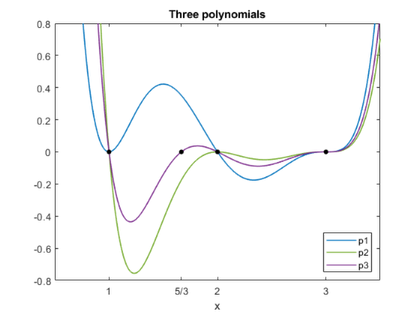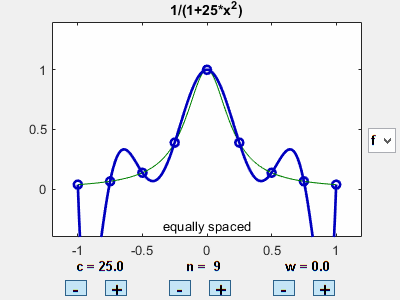
Lots of tiny bubbles.... 続きを読む >>

Lots of tiny bubbles.... 続きを読む >>

In an unpublished 1972 technical report "Conserving confluence curbs ill-condition," Velvel Kahan coined the descriptive term pejorative manifold. In case you don't use it in everyday conversation, pejorative means "expressing contempt or disapproval."... 続きを読む >>

In an unpublished 1972 technical report "Conserving confluence curbs ill-condition," Velvel Kahan coined the descriptive term pejorative manifold. In case you don't use it in everyday conversation, pejorative means "expressing contempt or disapproval."... 続きを読む >>

This post is by my colleague Cosmin Ionita.... 続きを読む >>

As the degree of an interpolating polynomial increases, does the polynomial converge to the underlying function? The short answer is maybe. I want to describe a visual tool to help you investigate this question yourself.... 続きを読む >>

Two months ago I wrote a blog post about Teaching Calculus to a Deep Learner. We wrote the code for that post in one afternoon in the MathWorks booth at the SIAM Annual Meeting. Earlier that day, during his invited talk, MIT Professor Gil Strang had spontaneously wondered if it would possible to teach calculus to a deep learning computer program. None of us in the booth were experts in deep learning.... 続きを読む >>

MIT's Professor Gil Strang gave two talks in one morning recently at the SIAM annual meeting. Both talks derived from his experience teaching a new course at MIT on linear algebra and neural nets. His first talk, "The Structure of a Deep Neural Net", was in a minisymposium titled "Deep Learning and Deep Teaching", which he organized. Another talk in that minisymposium was by Drexel's Professor Pavel Grinfeld on "An Informal Approach to Teaching Calculus." An hour later, Gil's gave his second talk, "Teaching About Learning." It was an invited talk at the SIAM Conference on Applied Mathematics Education.... 続きを読む >>

The ACM Special Interest Group on Programming Languages, SIGPLAN, expects to hold the fourth in a series of conferences on the History of Programming Languages in 2020, see HOPL-IV. The first drafts of papers are to be submitted by August 2018. That long lead time gives me the opportunity to write a detailed history of MATLAB. I plan to write the paper in sections, which I'll post in this blog as they are available.... 続きを読む >>
Two days ago I wrote about random points in a square. At the last minute I added the paragraph asking about the generalization to random points in a cube. I have to admit that I didn't check the Web to see what was known about the question.... 続きを読む >>

How far apart can you expect two points chosen at random in the unit square to be? I found this problem on the YouTube channel maintained by Presh Talwalkar, Mind Your Decisions. He correctly calls it a very hard puzzle. At first, I guessed the answer might be $1/2$. But the correct answer is more interesting than that.... 続きを読む >>